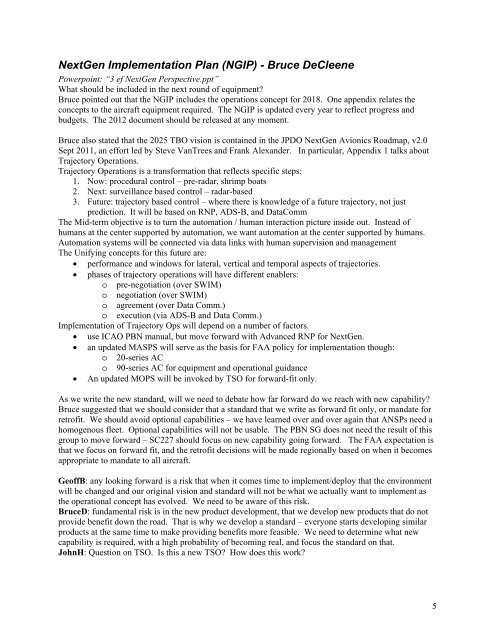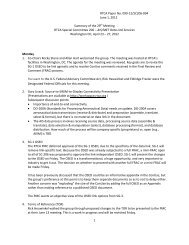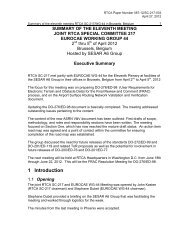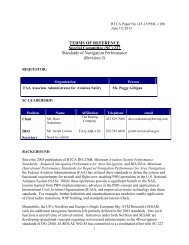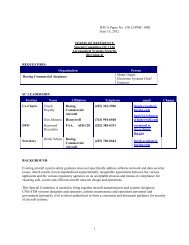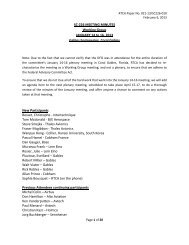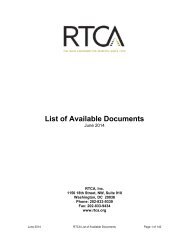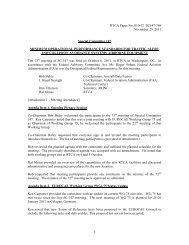Summary of the First Meeting Special Committee 227 ... - RTCA
Summary of the First Meeting Special Committee 227 ... - RTCA
Summary of the First Meeting Special Committee 227 ... - RTCA
Create successful ePaper yourself
Turn your PDF publications into a flip-book with our unique Google optimized e-Paper software.
NextGen Implementation Plan (NGIP) - Bruce DeCleene<br />
Powerpoint: “3 ef NextGen Perspective.ppt”<br />
What should be included in <strong>the</strong> next round <strong>of</strong> equipment<br />
Bruce pointed out that <strong>the</strong> NGIP includes <strong>the</strong> operations concept for 2018. One appendix relates <strong>the</strong><br />
concepts to <strong>the</strong> aircraft equipment required. The NGIP is updated every year to reflect progress and<br />
budgets. The 2012 document should be released at any moment.<br />
Bruce also stated that <strong>the</strong> 2025 TBO vision is contained in <strong>the</strong> JPDO NextGen Avionics Roadmap, v2.0<br />
Sept 2011, an effort led by Steve VanTrees and Frank Alexander. In particular, Appendix 1 talks about<br />
Trajectory Operations.<br />
Trajectory Operations is a transformation that reflects specific steps:<br />
1. Now: procedural control – pre-radar, shrimp boats<br />
2. Next: surveillance based control – radar-based<br />
3. Future: trajectory based control – where <strong>the</strong>re is knowledge <strong>of</strong> a future trajectory, not just<br />
prediction. It will be based on RNP, ADS-B, and DataComm<br />
The Mid-term objective is to turn <strong>the</strong> automation / human interaction picture inside out. Instead <strong>of</strong><br />
humans at <strong>the</strong> center supported by automation, we want automation at <strong>the</strong> center supported by humans.<br />
Automation systems will be connected via data links with human supervision and management<br />
The Unifying concepts for this future are:<br />
performance and windows for lateral, vertical and temporal aspects <strong>of</strong> trajectories.<br />
phases <strong>of</strong> trajectory operations will have different enablers:<br />
o pre-negotiation (over SWIM)<br />
o negotiation (over SWIM)<br />
o agreement (over Data Comm.)<br />
o execution (via ADS-B and Data Comm.)<br />
Implementation <strong>of</strong> Trajectory Ops will depend on a number <strong>of</strong> factors.<br />
use ICAO PBN manual, but move forward with Advanced RNP for NextGen.<br />
an updated MASPS will serve as <strong>the</strong> basis for FAA policy for implementation though:<br />
o 20-series AC<br />
o 90-series AC for equipment and operational guidance<br />
An updated MOPS will be invoked by TSO for forward-fit only.<br />
As we write <strong>the</strong> new standard, will we need to debate how far forward do we reach with new capability<br />
Bruce suggested that we should consider that a standard that we write as forward fit only, or mandate for<br />
retr<strong>of</strong>it. We should avoid optional capabilities – we have learned over and over again that ANSPs need a<br />
homogenous fleet. Optional capabilities will not be usable. The PBN SG does not need <strong>the</strong> result <strong>of</strong> this<br />
group to move forward – SC<strong>227</strong> should focus on new capability going forward. The FAA expectation is<br />
that we focus on forward fit, and <strong>the</strong> retr<strong>of</strong>it decisions will be made regionally based on when it becomes<br />
appropriate to mandate to all aircraft.<br />
Ge<strong>of</strong>fB: any looking forward is a risk that when it comes time to implement/deploy that <strong>the</strong> environment<br />
will be changed and our original vision and standard will not be what we actually want to implement as<br />
<strong>the</strong> operational concept has evolved. We need to be aware <strong>of</strong> this risk.<br />
BruceD: fundamental risk is in <strong>the</strong> new product development, that we develop new products that do not<br />
provide benefit down <strong>the</strong> road. That is why we develop a standard – everyone starts developing similar<br />
products at <strong>the</strong> same time to make providing benefits more feasible. We need to determine what new<br />
capability is required, with a high probability <strong>of</strong> becoming real, and focus <strong>the</strong> standard on that.<br />
JohnH: Question on TSO. Is this a new TSO How does this work<br />
5


